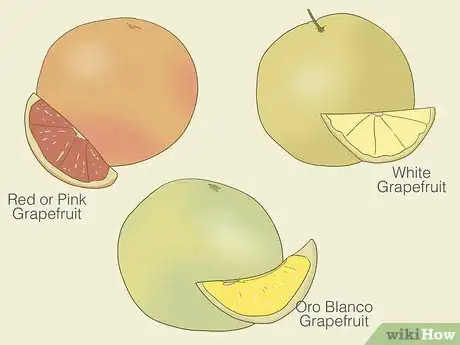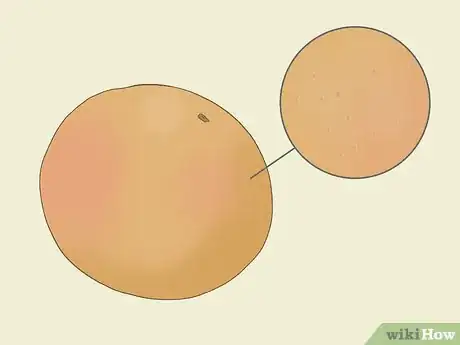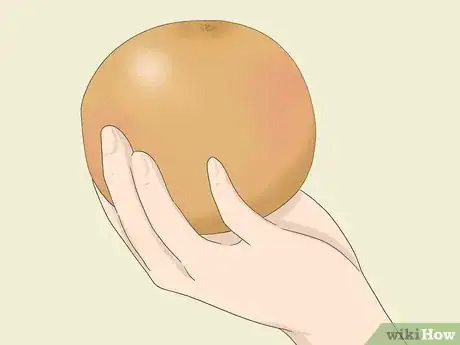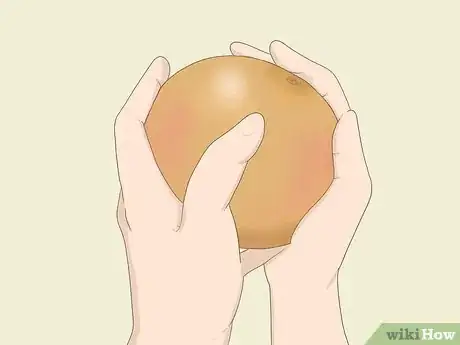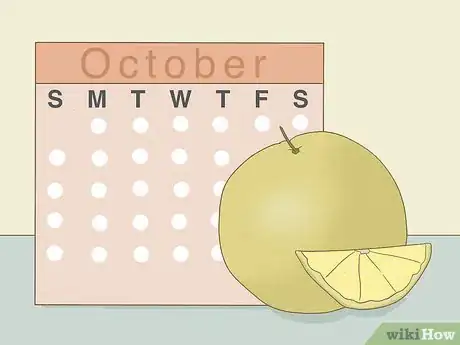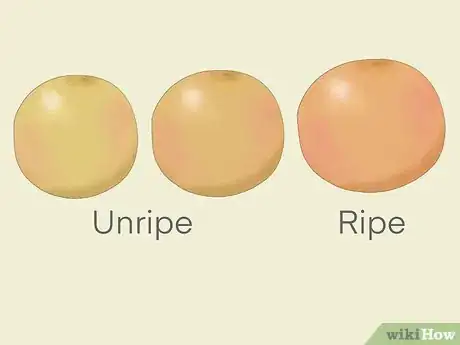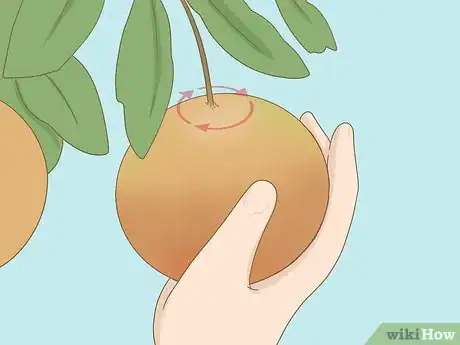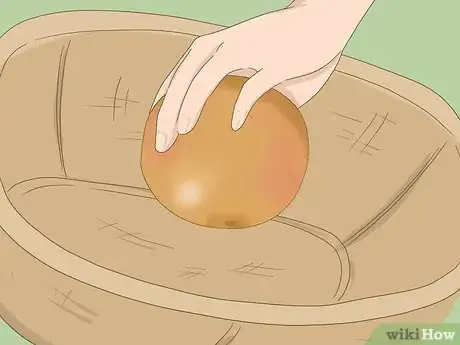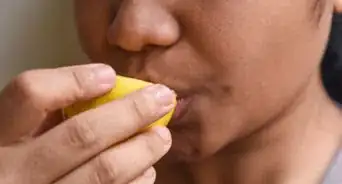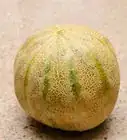This article was co-authored by wikiHow Staff. Our trained team of editors and researchers validate articles for accuracy and comprehensiveness. wikiHow's Content Management Team carefully monitors the work from our editorial staff to ensure that each article is backed by trusted research and meets our high quality standards.
There are 10 references cited in this article, which can be found at the bottom of the page.
This article has been viewed 37,405 times.
Learn more...
Grapefruit is a type of citrus that is great as a healthy snack, juice, or garnish. It has a sweet, slightly bitter, and sometimes tart taste that many people love. The key to getting the most flavorful grapefruit is by knowing what to expect from a ripe one. Look for firm fruit with heavy skin, among other signs. If you have your own grapefruit trees, pluck the fruit by hand once it has had a chance to ripen. Then, come up with a way to serve the grapefruit to get the most out of its fresh flavor.
Steps
Spotting Ripe Grapefruit
-
1Look for a uniform color on the grapefruit’s peel. Since there are a few different varieties of grapefruit available, the peel color varies. However, the most common varieties look similar to oranges and have an orange-colored peel. As long as the peel looks consistent, you will probably end up with a ripe grapefruit. Don’t choose a grapefruit with spots unless you’re getting an oro blanco.[1]
- Red and pink grapefruit are the easiest varieties to find in stores and usually look like big oranges. The peel may have a red tint to it sometimes.
- A white grapefruit looks more like a round lemon and has a bright yellow peel.
- An oro blanco grapefruit is a little different since it is a cross between a white grapefruit and another fruit called a pomelo. It is often green with yellow spots. The green color and spots don't mean the fruit isn’t ripe!
-
2Select a fruit that is flat on the top and bottom. Inspect the side with the little bud where the grapefruit’s stem was. Then, turn the grapefruit over to check out the opposite side. When these sides are flat, the grapefruit will have an oval shape instead of being perfectly round. The oval shape shows that it is ripe.[2]
- Most people pick out round fruit, but try to find the ones that don’t look perfect. The rounder ones usually were picked too soon.
Advertisement -
3Check the fruit for a smooth peel with small bumps on it. Take a closer look at the grapefruit’s outer surface, noticing any small indentations in it. Although the peel will feel smooth to the touch, you will be able to see a bunch of these small dimples all across it. Those dimples are one good sign of a healthy, ripe fruit.[3]
- If a grapefruit is perfectly smooth, it will probably look a little weird. Remember that the best grapefruits often aren’t the most picture-perfect ones.
-
4Choose a plump grapefruit that also feels heavy. Look for ones that look big and full of juice. Then, pick them up to give them a more thorough testing. Good grapefruits feel heavier than they look. If one surprises you with its weight, then it is likely very ripe.[4]
- If a grapefruit looks small and feels light, then it probably didn't have enough time to ripen. Although underripe grapefruit is still edible, expect it to be bitterer than usual and have less juice.
-
5Squeeze grapefruits to see if they feel firm instead of soft. Squeeze gently to avoid bruising the fruit. If it is ripe, its skin will bounce back to its original position right away. Then, turn the grapefruit a few times to squeeze it in other spots. Make sure it feels firm all the way around.[5]
- Soft spots or hidden wrinkles are signs that the grapefruit is spoiling. Soft spots can be from bacteria or even mold, so avoid any grapefruit that looks like it’s starting to go bad.
Removing Grapefruit from Trees
-
1Pick the grapefruit near the end of autumn. The exact time grapefruit turns ripe can vary depending on where you live. At a minimum, a grapefruit takes about 6 months to ripen. In areas that experience cold summers, it may take up to a year to fully ripen. Ideally, plan on picking the fruit near the beginning of the season, around November, and then waiting longer if necessary..[6]
- Grapefruit grows best in warmer areas, such as the southern part of the U.S. You can leave ripe fruit on the tree until about March or even May. It will get sweeter over time.
- In colder regions, such as the southern parts of Australia, grapefruit may need to be picked early on in the season to prevent it from spoiling. Grapefruit picked early tastes bitterer and more acidic.
- To decide when to pick grapefruit, taste the fruit. If it isn’t sweet enough for your liking, leave it alone. Many growers choose to pick grapefruit as late as April or May.
-
2Check to make sure the grapefruit is ripe before you pick it. One of the most recognizable signs is its color. Grapefruit starts out green but then turns yellow or orange. Wait for the fruit to change colors, then look for the ones that look big and heavy with juice. Select the ones that feel firm to the touch.[7]
- Even if some grapefruit looks ripe, it doesn't mean all the fruit on the tree has finished ripening. To ensure they are all ripe, leave as many as you can until the end of the picking season.
- Note that fruit on separate trees can ripen at a different rate. If you have time, check each grapefruit before picking it.
-
3Pick the grapefruit on the outer part of the tree first. Not all grapefruit ripens at the same time. The ones furthest from the trunk usually ripen first. When you go out to pick the fruit, start with those ones first. Check them to make sure they are at the right consistency before removing them from the tree.
- Citrus fruit doesn’t continue ripening after it is picked. Make sure the grapefruit has finished ripening and tastes the way you want before you take it off the tree!
-
4Twist the grapefruit with your hand to remove it from the tree. Fresh grapefruit is very easy to pick. Firmly grasp the bottom of the fruit, then rotate it to the left or right. It will slide off the stem without any difficulty. If you have pruning shears, you could also clip the stem off.[8]
- Most grapefruit grows on what is known as a dwarf tree. Dwarf trees are so short that even small children can reach the fruit! Picking grapefruit doesn’t require any special tools, but bring a ladder in case some of it is out of reach.
- Some grapefruit may fall off the tree before you pick it. It’s still safe to eat, but check it for bugs or other signs of damage first.
-
5Place the grapefruit gently in a basket. It can be tempting to toss or drop them, but that could bruise the fruit. Keep a portable storage container accessible nearby. Lay the grapefruit one by one inside it. Make sure it can’t fall out while you’re transporting the container home.[9]
- Bruised grapefruit spoils more quickly. To keep it fresh for longer, take care of it!
References
- ↑ https://www.betterhealth.vic.gov.au/health/ingredientsprofiles/Grapefruit
- ↑ https://www.mercurynews.com/2015/12/15/how-to-choose-the-sweetest-grapefruit/
- ↑ https://www.pickyourown.org/citruspickingtips.htm
- ↑ https://www.dmagazine.com/publications/d-home/2015/january-february/how-to-buy-the-perfect-grapefruit/
- ↑ https://spoonuniversity.com/how-to/how-to-tell-when-grapefruits-are-ripe-and-ready-to-eat
- ↑ http://blogs.ifas.ufl.edu/nassauco/2018/01/08/can-tell-citrus-fruit-ripe/
- ↑ https://cals.arizona.edu/extension/ornamentalhort/landscapemgmt/plantmaterial/citrusvar.pdf
- ↑ https://hort.purdue.edu/newcrop/morton/grapefruit.html
- ↑ https://www.pickyourown.org/citruspickingtips.htm
